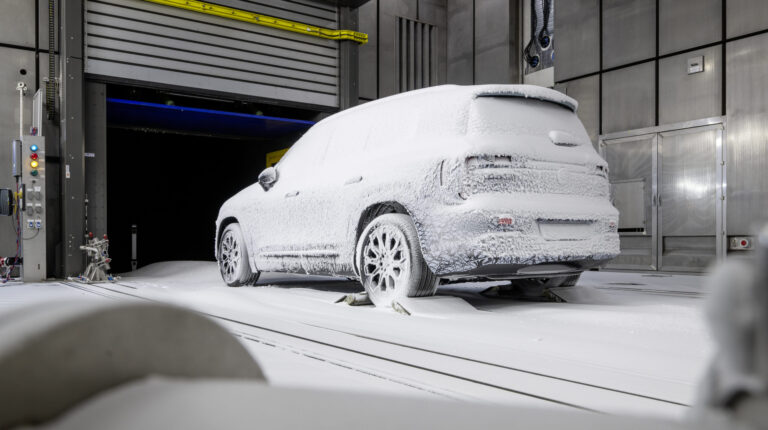Engineers at Mercedes‑Benz are currently completing cold-weather validation of the all-new GLB at the Mercedes Technology Center in Sindelfingen, Germany, including testing in two state-of-the-art climatic wind tunnels, before the vehicle’s reveal in December.
Temperature at the facility can be adjusted from -40°C to +40°C, and snow cannons can produce a variety of snow types. Combined with the wind tunnel’s high-powered fan, this enables the replication of blizzards at speeds of up to 200km/h.
In each tunnel, a rolling road simulates the road surface. Powerful electric motors drive four rollers each, enabling the OEM’s 4Matic models to be scrutinized under realistic conditions. Both rigs are designed for a total output of up to 780kW, enabling top speeds of up to 265km/h.
Vehicles can also be refueled and charged within the tunnels. In addition to the two test benches, there’s also a control room where technicians can regulate temperature, humidity wind speed and other parameters. Each test can be closely observed through large, fully insulated windows.
The resource also houses a heat chamber, where temperatures from -10°C to +60°C can be generated. A solar simulation system with 32 lamps produces a radiation spectrum equivalent to natural sunlight. Across an 8m × 2.5m area, radiation intensity can be adjusted between 200W/m² and 1,200W/m². The highest level is said to match extremely intense sunlight found only in remote desert locations, such as Death Valley in the USA.
Another development tool in the heat tunnel is the ‘Hot Road’ – a simulated road surface whose temperature can be continuously adjusted between +50°C and +70°C, accurately replicating the thermal conditions of pavement on a scorching summer day.
Engineers are using the climatic wind tunnels to test a range of vehicle components and functions. For example, they are assessing the performance of the windshield wipers to ensure they operate flawlessly in all weather conditions. In the cold tunnel, the engineers are also examining whether swirling snow can block the air intakes – a real-world risk caused by spray from passing trucks.

At frosty temperatures between -15°C and -20°C, the heating system must be able to defrost an icy windshield quickly. During evaluation, a camera records the entire de-icing process – the GLB is said to have performed impressively in these evaluations.
Mercedes‑Benz says that data captured in these facilities is helping to close the gap between simulation and physical testing.
In related news, Mercedes-Benz recently opened its new Light Testing Tunnel in Immendingen


